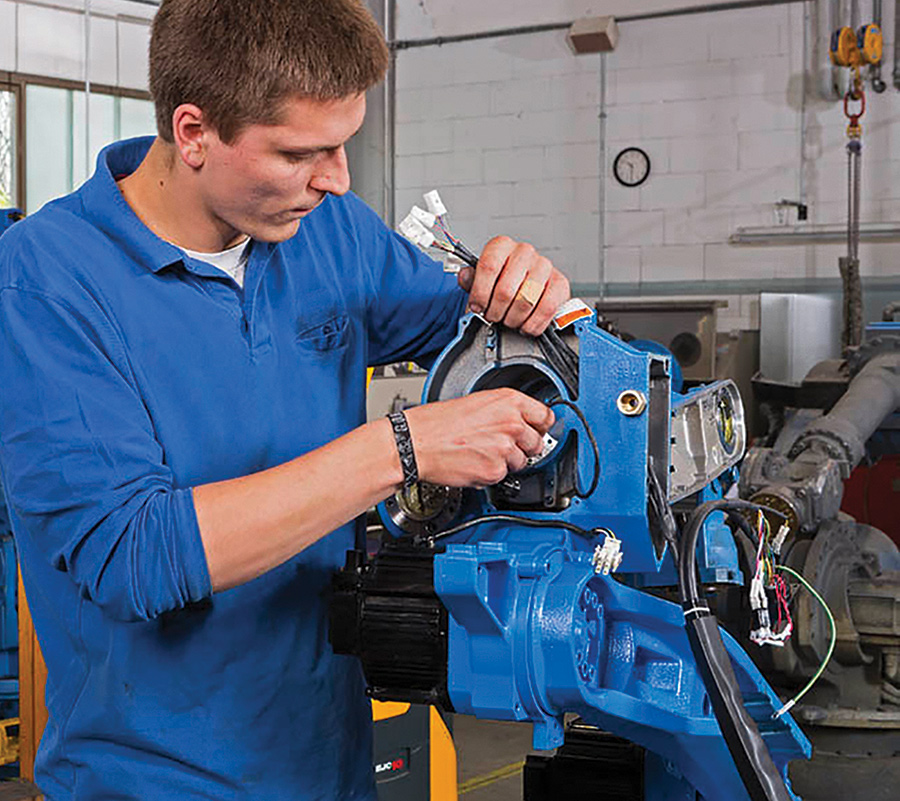
he science of sintering first emerged in the 1940s. The technology has since matured. Today, the heat treatment is used to increase the strength and structural integrity of materials. Salem, Indiana-based GKN Sinter Metals—an expert in powder metallurgy—uses sintering to produce precision powder metal products for a broad range of markets that include automotive, industrial and consumer applications. To meet the evolving demands of customers like General Motors, Ford Motor Co., Toyota Motor Corp. and Honda Motor Co., GKN has married its sintered metal processing skills with IIoT practices in a digitized production environment. That included installing a fleet of almost 30 Yaskawa Motoman 6-axis robots.
GKN Sinter Metals, a subsidiary of UK-based GKN Aerospace, began installing the robots over a decade ago throughout its 220,000-sq.-ft. manufacturing facility to automate its furnace loading process for transmission sprockets and carriers. Parts range in thicknesses from 0.125 in. to 2 in., diameters of 1 in. to 12 in. and weigh between 0.25 lbs. and 5 lbs.
Prior to investing in Yaskawa’s robot technology, GKN Sinter Metals’ workers were required to move each part manually from a briquette press to a holding area before transferring batches to a furnace. Now robots load components produced in the briquette press and transfer them into a furnace. Once parts exit the furnace, a robot unloads and packs them for shipment. GKN has cut processing time and boosted productivity by 15 percent.
 Dynamic acceleration/deceleration capabilities help to reduce cycle time for throughput optimization.
Dynamic acceleration/deceleration capabilities help to reduce cycle time for throughput optimization. 
GKN’s decision to automate has led to advantages beyond higher productivity. It has realized a cost savings as dunnage (packing material) is no longer required to hold parts produced at the briquette press. GKN also realized a 25 percent savings in scrap inventory due to a reduction in parts handling. The elimination of the manual multi-step transfer process reduced the number of chips and dents and improved product quality. Automation also allowed GKN to move one operator from each production location to manage other value-added tasks.
GKN Sinter Metals uses Yaskawa Motoman robots to automate operations for higher productivity and reduced scrap.

The ability to partner with the right equipment supplier for training, service and support is a step often overlooked in the successful integration of automation. Yaskawa Support Services (YSS) installed the robots. A group of GKN employees attended the IACET-accredited Yaskawa Academy to receive hands-on training with the equipment. The GKN group was also equipped to lead training sessions for other employees.

A life-cycle management component means Yaskawa service technicians perform robot preventive maintenance from an annual tune-up and/or three-year preventive procedure to impromptu service suggestions by a field technician. Field service is performed by factory-trained technicians located throughout the Americas. In addition to repairs, programming maintenance and system audits are done with minimal downtime.
“Yaskawa has a 99.95 percent first-time fix rate that has minimized downtime for manufacturers like GKN and accelerated ROI,” says Elkins. “We also facilitate rapid on-site response with access to a 24/7 expert coverage hotline. The hotline is an asset for companies like GKN. They can call in for basic repair help, part ordering and programming tips. There are also online how-to videos to augment support.”
YSS carries $30 million in parts inventory. Repair and retrofit services include keeping robots up to date with new options and software upgrades. Complete robot rebuilds can also be performed to extend the life cycle of the equipment.
“Our ability to partner with customers at every stage of a project is instrumental in their ability to realize productivity gains,” Elkins claims. “Adopting a three-dimensional approach that combines advanced technologies, helps to fill the void left by labor shortages, and provides aftermarket service and support is essential for manufacturers that want to retain an optimal position in the marketplace.”